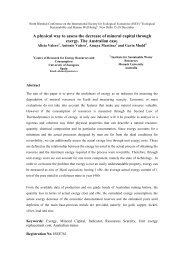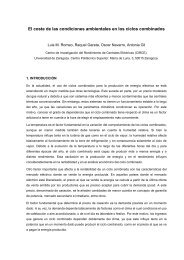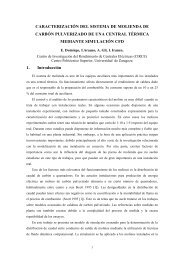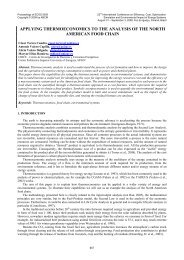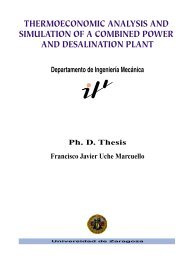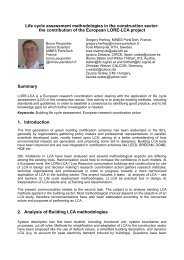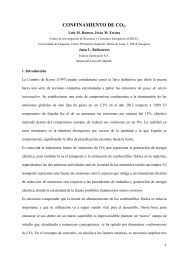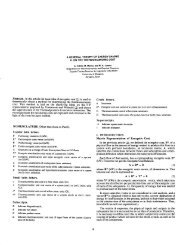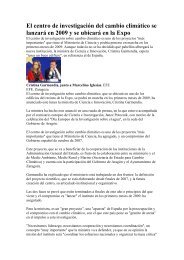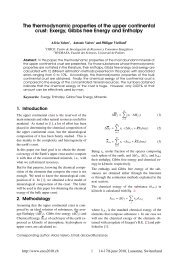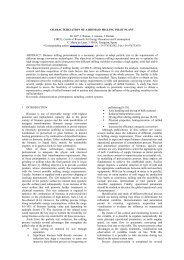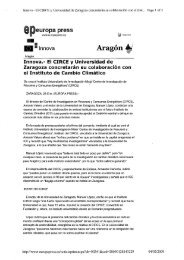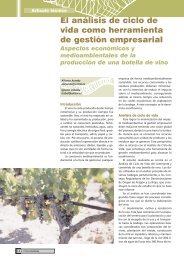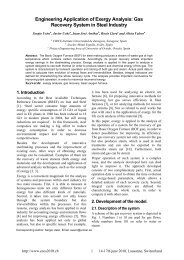towards an international legal reference environment
towards an international legal reference environment
towards an international legal reference environment
You also want an ePaper? Increase the reach of your titles
YUMPU automatically turns print PDFs into web optimized ePapers that Google loves.
Fe appears in form of free oxide Fe2O3. The remaining<br />
part appears in form of FeTiO3, FeCr2O3<br />
<strong>an</strong>d silicates. For example, following silicates<br />
were assumed: NaAlSi3O8, KAlSi3O8, NaFeSi2O6,<br />
MgSiO3, CaO.Al2Si2O7. Because of the large content<br />
of SiO2, a considerable part of it was assumed<br />
in free form. After estimating the composition of a<br />
me<strong>an</strong> sample of the lithosphere, its molecular mass<br />
was calculated.<br />
R<strong>an</strong>z [13] updated the molecular mass of the upper<br />
continental crust using more recent geochemical<br />
information <strong>an</strong>d adopting not only a geochemical<br />
approach, but also a geological one. The methodology<br />
used was as follows: The <strong>international</strong><br />
accepted norm CIPW [29] was applied to the mass<br />
fractions of the principal oxide groups obtained by<br />
Carmichael [30] for the cratonic <strong>an</strong>d sedimentary<br />
layers, in order to redistribute the chemical components<br />
from the oxides to the mineral molecules<br />
that are representative in real minerals appearing in<br />
a rock. Next, the minerals of the norm <strong>an</strong>d their<br />
respective relative masses were modified to adjust<br />
them to the real volumes of the principal groups of<br />
each rock. Finally, their molar fractions were calculated<br />
<strong>an</strong>d the me<strong>an</strong> molecular mass of the whole<br />
was obtained. The resulting M0 was equal to 145,5<br />
kg/kmol. Even though this methodology used better<br />
geochemical values th<strong>an</strong> the ones in Szargut [28],<br />
<strong>an</strong>d included the geological approach, we c<strong>an</strong>not<br />
forget that the CIPW norm is <strong>an</strong> artificial way to obtain<br />
the possible minerals that c<strong>an</strong> appear in a rock.<br />
It is therefore only <strong>an</strong> approximation as well.<br />
In the light of Grigor’ev’s <strong>an</strong>alysis, a more accurate<br />
molecular weight of the upper continental crust,<br />
based on experimental results rather th<strong>an</strong> assumptions,<br />
c<strong>an</strong> be easily obtained. The new calculated<br />
value is M0= 143,4 kg/kmol, which is very close to<br />
the estimation done by R<strong>an</strong>z. The difference in the<br />
chemical exergy of the elements obtained with the<br />
new molecular weight is almost negligible: in average,<br />
taking a molecular weight equal to 143,4 instead<br />
of 145,5, makes a difference in the exergy of<br />
the solid <strong>reference</strong> subst<strong>an</strong>ces of only 0,007%.<br />
For the fraction of the i-th element appearing in the<br />
form of <strong>reference</strong> species (coefficient ci), Szargut<br />
[31] associates values comprised between 0,5 for<br />
more abund<strong>an</strong>t subst<strong>an</strong>ces <strong>an</strong>d 0,001 for less frequent<br />
subst<strong>an</strong>ces from geochemical data given by<br />
Pol<strong>an</strong>ski <strong>an</strong>d Smulikowski [21]. R<strong>an</strong>z [13] obtained<br />
more accurate ci coefficients for solid R.S. containing<br />
the most abund<strong>an</strong>t elements in the upper continental<br />
crust. For this purpose, she used the mineralogical<br />
composition of the Earth’s upper layer<br />
obtained with the CIPW norm before <strong>an</strong>d updated<br />
geochemical information, mainly from Taylor <strong>an</strong>d<br />
McLenn<strong>an</strong> [23]. For minority elements, due to the<br />
lack of information, Szargut’s [31] values were used.<br />
As long as a better mineralogical composition of the<br />
Earth’s crust is done <strong>an</strong>d the ci coefficients are recalculated<br />
with this information, we will assume the ci<br />
values obtained by R<strong>an</strong>z [13]. Nevertheless, it must<br />
be stressed that choosing a certain ci or <strong>an</strong>other a<br />
100 times greater, throws less differences in the chemical<br />
exergy of the elements th<strong>an</strong> choosing <strong>an</strong>other<br />
R.S.<br />
Table 4 shows the results obtained in this study for<br />
the chemical exergy of the solid subst<strong>an</strong>ces. The<br />
solid R.S. assumed were those taken by Szargut<br />
[12], basing on the Szargut’s criterion mentioned<br />
before. The new chemical exergies obtained differ in<br />
1,1% in average with respect to the values obtained<br />
by Szargut in [12]. Taking the empirical st<strong>an</strong>dard<br />
molar concentration of solid R.S. found in Grigor’ev<br />
[27] instead of calculating it with Eq. 3, implies<br />
a difference in the element chemical exergy of less<br />
th<strong>an</strong> 4% except for Au (14%) <strong>an</strong>d F (18%). For the<br />
latter elements, the greater difference is due to the<br />
greater sensitivity of Au to z0, since its ∆G is equal<br />
to zero <strong>an</strong>d the great proportion of atoms of Ca in<br />
the <strong>reference</strong> subst<strong>an</strong>ce of F, respectively.<br />
Reference subst<strong>an</strong>ces dissolved in seawater<br />
Methodology<br />
Assumption of ionic or molecular R.S. dissolved in<br />
seawater ensures in m<strong>an</strong>y cases more exact determination<br />
of st<strong>an</strong>dard chemical exergy of chemical elements<br />
when compared with solid R.S. The calculation<br />
methods of thermodynamic functions of monocharged<br />
<strong>an</strong>d bicharged ions are relatively exact. This<br />
is the case also when the <strong>reference</strong> subst<strong>an</strong>ce is dissolved<br />
in molecular form with a very small degree<br />
of ionization.<br />
The method of calculation of st<strong>an</strong>dard chemical<br />
exergy of elements with R.S. dissolved in seawater<br />
has been developed by Morris [32]:



